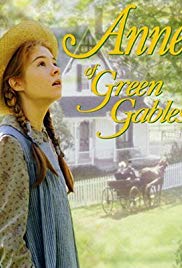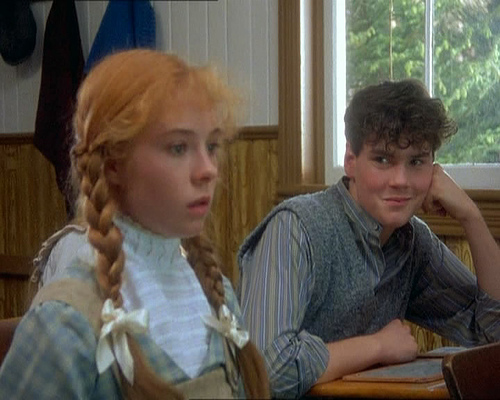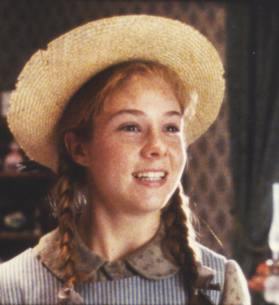ANNE OF GREEN GABLES
SUBJECTS — World/Canada;
SOCIAL-EMOTIONAL LEARNING — Coming of Age; Female Role Model;
MORAL-ETHICAL EMPHASIS — General.
AGE; Age: 8+; Not Rated;
Drama; 1985; 199 minutes; Color. Available from Amazon.com.
There is NO AI content on this website. All content on TeachWithMovies.org has been written by human beings.

SUBJECTS — World/Canada;
SOCIAL-EMOTIONAL LEARNING — Coming of Age; Female Role Model;
MORAL-ETHICAL EMPHASIS — General.
AGE; Age: 8+; Not Rated;
Drama; 1985; 199 minutes; Color. Available from Amazon.com.
TWM offers the following movie worksheets to keep students’ minds on the film and to focus their attention on the lessons to be learned from the movie.
Film Study Worksheet for a Work of Historical Fiction;
Film Study Worksheet for ELA Classes; and
Worksheet for Cinematic and Theatrical Elements and Their Effects.
Teachers can modify the movie worksheets to fit the needs of each class. See also TWM’s Historical Fiction in Film Cross-Curricular Homework Project and Movies as Literature Homework Project.
Additional ideas for lesson plans for this movie can be found at TWM’s guide to Lesson Plans Using Film Adaptations of Novels, Short Stories or Plays.
This movie is a warmhearted portrayal of the adolescence of an orphan girl after she finds a home with an elderly brother and sister. The action takes place on Prince Edward Island at the turn of the 20th century. The film is based on the classic novel by Lucy Maud Montgomery. Children will benefit from reading the book before seeing the movie.
Selected Awards: None.
Featured Actors: Megan Follows, Colleen Dewhurst, Richard Farnsworth, Patricia Hamilton and Schuyler Grant.
Director: Kevin Sullivan.
This is a richly produced film which gives us a sense of what life was like in rural Canada at the turn of the 20th century. The movie also explores how a girl’s mind works, explaining, for example, Anne’s fears of not being beautiful. The movie is full of role models.
NONE.
Should your middle school child be assigned to read Lucy Maud Montgomery’s novel, Ann of Green Gables, be sure that he or she waits until after having finished reading the book before viewing the film. The novel is a character study showing the impact of time and place on women. Should your child show enough interest in the ideas found in both the film and the book, you may want to enrich his or her understanding by sharing information about concepts of beauty and the temperance movement explained in the Helpful Background section of this Guide.

Mrs. Lind refers at one point to “demon liquor.” In the late 19th and early 20th centuries, there was a very strong movement to prohibit the consumption of alcohol. It was led by the Women’s Christian Temperance Union. “Prohibition” was enacted into law in the United States through the 18th Amendment to the Constitution from 1919 to 1933. Prohibition was an utter failure. It drove the consumption of alcohol underground. It led to the development and enrichment of strong criminal organizations such as the Mafia.
Several states permitted women’s suffrage beginning in 1890 when Wyoming entered the Union with a constitution permitting women to vote. The major role played by women in helping the Allies win World War I and their non-violent campaign demanding the vote made it clear that women’s suffrage was a reform whose time had come. (See “Iron Jawed Angels”.) With more and more states granting suffrage to women, the 19th Amendment to the U.S. Constitution was adopted in 1920, giving women the vote in federal and state elections. Women were granted suffrage in Canada in 1918.
Mrs. Cuthburt refers to Anne as a “heathen” because she has not been schooled in religion. The term heathen refers to someone who does not believe in the prevailing religion, in this case Christianity. A “gentlewoman of reduced circumstances” was a woman who was once well to do and who has retained her good reputation despite falling on hard times. Often they were widows. Sometimes to make ends meet, they converted their large homes into boarding houses and rented out rooms.
1. See Discussion Questions for Use With any Film that is a Work of Fiction.
2. Why was Anne ashamed of her red hair?

Discussion Questions Relating to Ethical Issues will facilitate the use of this film to teach ethical principles and critical viewing. Additional questions are set out below.
1. Analyze the actions of any major character in the film applying two tests which any ethical action must pass: (1) The Golden Rule (Would the person taking the action want to be treated the same way? or to put it another way “Do unto others as you would have others do unto you”) and (2) universality (Would the person taking the action want all persons to act the same way in a similar situation?).
2. The plots of most films turn on one or more ethical choices which must be made by the characters in the movie. Which of The Six Pillars of Character, if any, are involved in the plot of this film? Tell us whether the ethical decisions made by the characters complied with the standards set out in the Six Pillars. Justify your opinion.
For convenience, the Six Pillars of Character are set out below.
(Be honest; Don’t deceive, cheat or steal; Be reliable — do what you say you’ll do; Have the courage to do the right thing; Build a good reputation; Be loyal — stand by your family, friends and country)
(Treat others with respect; follow the Golden Rule; Be tolerant of differences; Use good manners, not bad language; Be considerate of the feelings of others; Don’t threaten, hit or hurt anyone; Deal peacefully with anger, insults, and disagreements)
(Do what you are supposed to do; Persevere: keep on trying!; Always do your best; Use self-control; Be self-disciplined; Think before you act — consider the consequences; Be accountable for your choices)
(Play by the rules; Take turns and share; Be open-minded; listen to others; Don’t take advantage of others; Don’t blame others carelessly)
(Be kind; Be compassionate and show you care; Express gratitude; Forgive others; Help people in need)
(Do your share to make your school and community better; Cooperate; Stay informed; vote; Be a good neighbor; Obey laws and rules; Respect authority; Protect the environment)
The book Anne of Green Gables is excellent reading for teenagers. A book on the suffrage movement suitable for middle school and junior high readers is The Day the Women Got the Vote: A Photo History of the Women’s Right’s Movement by George Sullivan.
This Learning Guide was last updated on July 18, 2011.